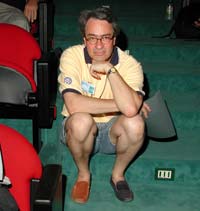| 2002 European Teams Championships | Page 7 | Bulletin 7 - Saturday, 22 June 2002 |
|
| ||
|
Hungary vs Sweden Open Round 15
Four Hearts was the popular contract, but hardly anyone made it. The 4-1 trump split was too hot to handle, since the danger of getting shortened in trumps was always there. In fact, in the Closed Room the Hungarian declarer didn't come any further than nine tricks and therefore the save by Magnus Lindkvist in the Open Room in 4ª doubled down two cost him money. Back to the 'impossible' 4©. Impossible ? Perhaps not. With all cards
open one might find the solution. Let's say East leads a spade to
the ace of his partner who returns the suit. Declarer ruffs, cashes
the ©10 and notices the
unfavourable trump split. He plays a club to the king, and plays
another three rounds of trumps. This is the position:
In the Closed Room, PO played in 3NT. West led a spade, East cashed his two top spades and played another one for Sundelin's queen. Declarer cashed first all his high cards in the minor suits and nothing favourable happened to him. He now relied on the heart finesse, alas, down two. In the open room Kemény had a clue which Sundelin lacked: East had opened the bidding. So here declarer had every reason to finesse the §Q 11 IMPs to Hungary. Board 14 was interesting in relation to slam bidding.
When you are playing a natural system it seems to be very difficult, perhaps impossible, to reach 6¨. Though it is very understandable that the Hungarians bid 6© it is not the right contract. On a club lead and the trumps 4-2 or worse, you go down. Playing a strong club system makes life sometimes easier. Jovi
Smederevac and Sascha Wernle playing for Austria against Switzerland
for example had a characteristic Blue Club sequence:
* knows that §A or ¨A will do Another interesting point is that 6¨ is even a better contract than 3NT. In one of the women's matches declarer went down in 3NT after a club lead by South for jack and king, a club to the queen and the eight of clubs, ducked in dummy. | |||||||||||||||||||||||||||||||||||||||||||||||||||||||||||||||||||
|
|
| Page 7 |


